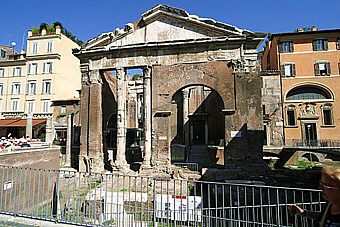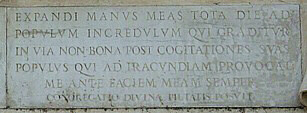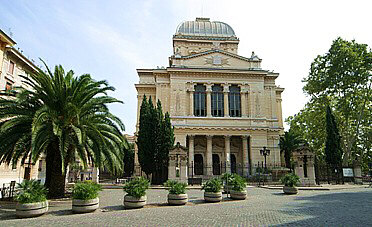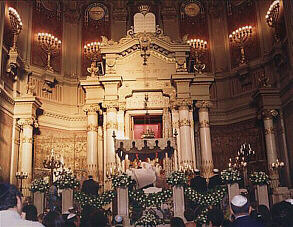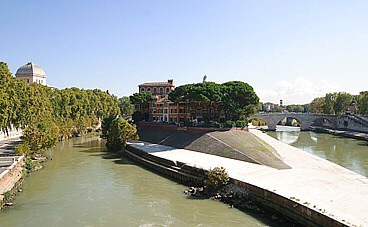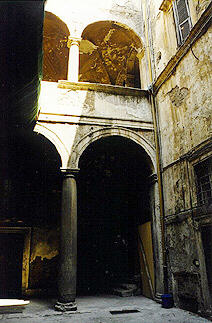| Rome Guide |
MUSIC: |
Bashanah habaa - Next year (Jewish traditional song) |
The Jewish Quarter or "Ghetto", the Roman Jews, and Jewish Rome
Rome's Jews are Europe's longest surviving Jewish community and
occupy a unique place in the history of the Diaspora. Jews have
been living in Rome, as well as in other Mediterranean cities, since
the 4-5th century BC. Palestine was an overcrowded land, at times
troubled also with military occupations. The Jews migrated to the
other Mediterranean towns, where they formed communities. In ancient
Rome they were generally well tolerated, and there were emperors
like Julius Caesar who established good relations with the community.
|
APARTMENTS FOR RENT IN THIS
QUARTER
"CARAVAGGIO",
a large, fine and quaint studio, with separate kitchen, bathroom,
foyer (2 persons).
"MARCO
POLO", a one bedroom, sitting room attic with large roof
garden with spectacular views of all Rome, (2-3 persons).
"BOTTICELLI":
a two double bedroom, sitting room, dining room 2 bathroom apt.,
with patio and fireplace (4-5 p.).
|
|
The heart of the quarter: Via Portico d'Ottavia |
Compared to the rest of Europe, the Jews had a surprising degree of security, although there were hard times here too. The capital of the Christian Church was comparatively a safe haven, but on the other hand the Church imposed taxes on Roman Jews, the first dating back in 1310, officially for their protection from outbreaks of popular violence against them.
After the bull "Cum Nisi Absurdum" issued by the anti-Semitic Pope Paul IV in 1555, the walls of the Ghetto (a word Venetian in origin) were built, separating the Jewish and Christian parts of the city. The Jews lost any property rights, and suffered of trading restrictions. They were only allowed to trade second hand objects, and could not have Christian personnel. Although at times the restraints were mitigated (and thus also craftmen, bankers, antique dealers and jewelers could be found), most Roman Jews were restrained to work in the rag trade.
The ghetto hosted nearly 4,000 Jews, cramped in a small neighbourhood in squalid conditions, where they were confined during night time.
The Via Portico d'Ottavia is still the centre of Jewish life in Rome. It used to mark the Ghetto's boundary.
It takes its name from the porch of Octavia's market, which is situated at its end. The street is a lively hotchpotch of ancient, medieval and Renaissance architecture.
Octavia's porch is still intact, yet presently within its space instead of the market you find a Catholic church (photo below).
|
|
The Portico d'Ottavia (Octavia's market porch)
|
Moreover, oppression occured in everyday life. The Jews were periodically compelled to attend mass in Catholic churches, where they were lectured to convert.
A marble slab in the facade of one of these churches, bordering the quarter (Santa Maria della Pieta'), remembers the atmosphere of those years. In two languages (Hebrew and Latin), it engraves an offensive and threatening interpretation of Isaias' profecy (Chapter 65:2):
|
|
"I have spread forth my hands all the day to an unbelieving people, who walk in a way that is not good, after their own thoughts. A people that continually provoke me to anger before my face." |
The Roman Jews are rightfully proud to have endured such incredibly long-lasting and infamous oppression, and the formidable pressures to convert.
When the unification of Italy occured in 1870, the new Italian government destroyed the walls of the Ghetto,
and the Jews enjoyed a process of emancipation. They became a normal
and essential part of the Italian society. Many Jews became nationalists, and at the onset of fascism, many Jews endorsed it, or even became fascists themselves. This didn't spare them from the discriminatory "Racial Laws" of 1938, in which all Jews lost their public jobs, positions, and rights to attend even schools, because of their "race inferiority".
The experience left a lasting memory in the Italian Jews, arising reservations whether it is wise to integrate completely or to be assimilated in the Italian society.
In September 1943 the Nazi occupiers pretended 50kg of gold from
the community, to be given in 36 hours. Both Jews and non-Jews
responded and the goal was reached, but the Nazi still deported
over 2,000 Jews to Auschwitz. One fourth of Rome's Jews died, yet
the number would have been higher had it not been for the help of
wide sections of the Roman society, including the Catholic priesthood.
Pope Clemens XII though did not utter a single condemnation of the persecution, as he followed a policy of "neutrality", officially not to stir further hatred in the Nazi.
The Italian Jews follow their own rite, as their presence occurred before the destruction of the second Temple in 70 AD, and they are also not Sephardi (Oriental or Arab countries Jews), nor Ashkenazi (Eastern Europe Jews).
The imposing synagogue was designed by the two architects Armanni and Costa (1904 AD). It has a "neo-Assyrian-Babylonian" style, and it terminates in a large quadrangular aluminium dome.
|
|
The main Synagogue ("Il Tempio" or Temple ). |
|
The synagogue incorporates the Museo d'Arte Ebraica, a small museum of Roman Jewish life and ritual, which is very dear to the Jews.
Officially the entrance of the synagogue is allowed to all, yet currently because of understandable security measures it is very difficult to enter during religious cerimonies. In addition, some of the custodians of the temple ("Shammash") have a reputation of being rude and whimsical, and may not let people enter with very flimsy excuses. Practically, only the guided visit of both the synagogue and the museum is possible, after cerimony hours (entrance 7.5 Euro). |
The interior of the main Synagogue, during a celebration |
Currently the Jews practise all professions, and they contribute to the Italian culture also with many intellectuals. Most Italian Jews are quite happy to consider themselves Italian, and are considered by their compatriots an essential part of the broader Italian society. Some Jews even applied Hebrew root words to the word "Italia", deriving it from "I Tal Yah" - Island of the dew of God.
Only 4,000 Italian Jews migrated to Israel in the last 50 years (out of a community of 30,000 members). Most of them migrated just after WW2, after the disastrous experience of the holoucast and to contribute to the foundation of Israel. Typically, another part - still a minority - moved later motivated by cultural / religious reasons. They usually stay in Jerusalem for its special religious appeal, and they generally have a good economic background (on the contrary of the majority of the Jews migrating to Israel).
A third and final group, again a small minority, comprises those who move temporarily to Israel. They are generally moved by cultural and political motivations (to contribute to the Israeli society and to Zionism). In Israel they frequently undergo professional experiences. Some serve in the army, to support Israel.
Yet Roman Jews are mostly attached to Rome. "Next year in Jerusalem?" Yes, but only in prayers and in toasts: the large majority of Roman Jews plan to spend it in Rome... They are often scoffed at with affection by the other Jews as "the Pope's Jews", especially by the Israeli, who find them all too Italian.
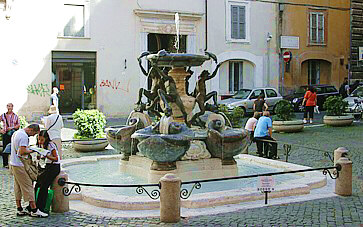 |
In the northern border of the quarter you also find the marvellous Tortoise Fountain (Fontana delle Tartarughe), in the little square in front of the patrician Palazzo Mattei (16th century), which includes fine interior marbles, statues and decorations.
The foutain was created (1581-1584) by the Florentine sculptor Taddeo Landini, following the design of Giacomo della Porta. From the large basin four large marble shells rise, upon which four ephebes (slender youth), stand with their foot on the head of bronze dolphins. |
Fountain delle Tartarughe and Palazzo Mattei (in the background)
|
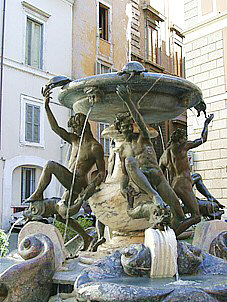 |

|
The ephebes raise their arms towards the final top marble shell.
The tortoises were inserted only in 1658. They are generally attributed to Bernini, although it is not certain. |
The quarter ends on one side with the Tiber, where the most ancient bridge in Rome, the Ponte Fabricius, leads to the little Tiberina Island.
The island includes the Catholic Basilica of St. Bartholomew, the Catholic hospital Fatebenefratelli, the Jewish hospital, and the Jewish review "Shalom".
Another bridge, the Sulpicius, leads to the Trastevere quarter (from the root words "Trans Tiber", beyond the Tiber). |
|
The Tiberina island, connected with the bridges Fabricius (left), to the Jewish quarter, and Sulpicius (right), to Trastevere |
|
An old palace of the ghetto in Via Portico d'Ottavia showing the degraded conditions of the quarter at the times of the ghetto. This photo was snapped in 1998. Presently this palace, and many others, were entirely renovated. |
To visit the other quarters, please go to:
|
|


